3-minute fly: Tie The Girdlebug nymph.

3-minute fly is a 6-part series by John Zimmerman of Casting For Hope and Upper Creek Angler.
Trees, rocks, big fish – they don’t care you spent half an hour on that perfectly tied fly.
I know because I’ve pleaded with them to give me back my precious flies before. Deaf ears!
I’ve been on a quest the last several years to identify simple flies that use simple, inexpensive materials, and take less than 3 minutes to tie. And I have a bunch of them.
The Girdlebug.
This bug is especially useful for fish that haven’t had a lot of pressure in slow water, or for all fish large enough to get their mouths around it in fast water.
With all the legs going this way and that in fast water, this fly initiates one strike after another.
One of the best things about it is that when fishing it, you really do often nail only solid fish – but of course you’ll pick up the random optimistic dink.
My friend Brownie Liles who runs Watauga River Lodge first introduced me to this fly. Brownie called it the Turd Fly (name obvious from the pictures of the finished fly), and I’ve also heard it called the Rubber Legged Stone.
I call it the Girdlebug because I like the story behind the name a lot better. Bob Nanney and Rex Wilson of the Waynesville, North Carolina area told me that the fly actually got its name because there was a lingerie factory in the area and the inventor of the fly used to take women’s girdles and remove the latex banding from them, cut the latex into strips, and use those for the legs on the fly.
I like that story and I love this fly!
Fly tying materials
Hook: Here I’m using a #10 4X long streamer hook.
Bead: Nymph-Head® Evolution™ Stonefly tungsten beadhead, gold—but try any variety of Nymph-Head® Evolution™, Heavy Metal™, or FlyColor™ beads in appropriate sizes; match colors to match the pheasant tail you’re using.
Thread: I’m using coffee colored Veevus in 8/0 here – but make sure you adjust to match the chenille you’re using.
Body: Coffee colored chenille is used here – but you should play with a wide variety of colors!
Rubber Legs: Span Flex brand rubber legs.
Fly tying instructions
Step 1
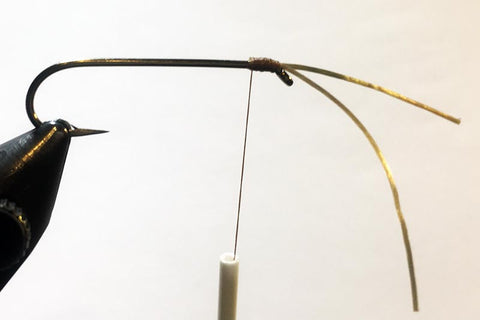
Tie in the first set of rubber legs coming off the head of the fly.
Step 2

Load and cement the bead on the thread base creased from tying in the rubber legs. Add a drop of Zap-A-Gap.
Step 3

Load about 20 turns of .020 lead wire.
Step 4

Cover the wire with thread.
Step 5

Tie in the rubber legs – 2 for legs and 3 sets going up the body of the fly.
Step 6
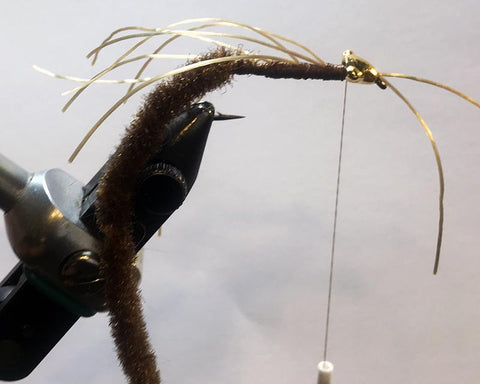
Return to the back of the hook and tie in the chenille.
A caveat: You can reverse steps 5 and 6. I just prefer not having the chenille in my way while I’m tying in the legs.
Step 7
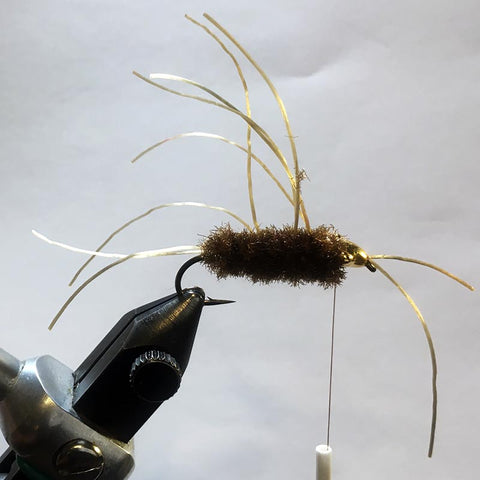
Having returned the thread to the front of the hook, advance the chenille forward, being sure not to trap any of the legs and tie off.
Step 8
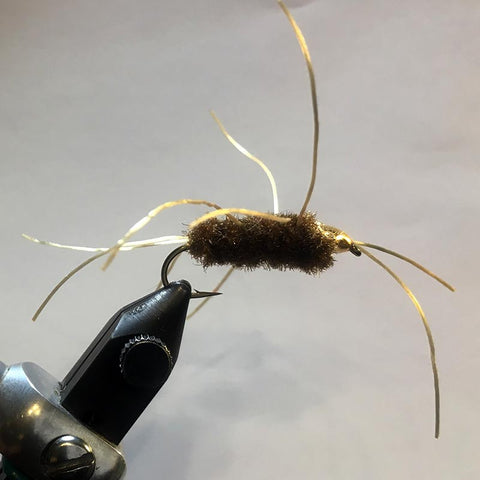
Adjust the legs by pulling them down on both sides.
Go fishing!
Want more articles like this?
Join the Flymen Mailing List at the bottom of the page!
Be sure to read John's recent post, They're at your feet, dude! 6 reasons to make shorter casts when wade fishing.
About John Zimmerman:
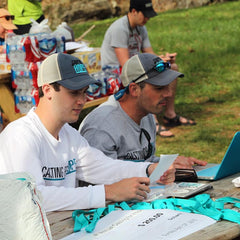 With Taylor Sharp (pictured left), John Zimmerman (right) is co-owner of Upper Creek Angler and co-founder and Chairman of the Board of directors of Casting for Hope. Upper Creek Angler is a guide and custom-built fly-rod service based in Morganton, NC. Casting for Hope is a regional nonprofit that serves women and families in Western North Carolina following a diagnosis of ovarian or other gynecological cancer through financial assistance and retreat programs. Casting for Hope’s flagship fundraiser is the only official Trout Legend Gold-Level fly-fishing competition on the east coast and one of just three in the United States. Watch the brief video below to learn more about Casting for Hope and the work John, Taylor, and their team are doing in WNC for women and families affected by ovarian and other gynecological cancers.
With Taylor Sharp (pictured left), John Zimmerman (right) is co-owner of Upper Creek Angler and co-founder and Chairman of the Board of directors of Casting for Hope. Upper Creek Angler is a guide and custom-built fly-rod service based in Morganton, NC. Casting for Hope is a regional nonprofit that serves women and families in Western North Carolina following a diagnosis of ovarian or other gynecological cancer through financial assistance and retreat programs. Casting for Hope’s flagship fundraiser is the only official Trout Legend Gold-Level fly-fishing competition on the east coast and one of just three in the United States. Watch the brief video below to learn more about Casting for Hope and the work John, Taylor, and their team are doing in WNC for women and families affected by ovarian and other gynecological cancers.
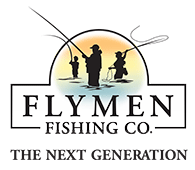

Comments on this post (6)
add me to fly tying
— tom wells
Add me to your list for new fly tying
— Chuck
THANK YOU…..I have been preaching this to everybody who ask me where are you catching all them fish..& I tell them look down there at
your feet….see the break from shallow to the 2nd
break…STOP…..& fish the shoreline vertically…
that’s where the fish hang….enjoy…catch & release
— john kowalski
I’ll definitely try it out, and tie my version today!
I’m sure it’s worth trying.
DonP
— Donald Parsons
Similar to the EMB used to catch huge Rainbow trout on the Barracoso River flowing into Largo Strobel (Jurassic Lake) in Argentina. I’m going to try these locally.
— Ron Sakoda
The Girdlebug patterns have been around for a long time. They are very productive fly. I fished them in Montana years ago and caught lots of nice both rainbows and brown trout . I especially liked them in the winter and early spring . A must have fly in your arsenal .
— Randy Beavis